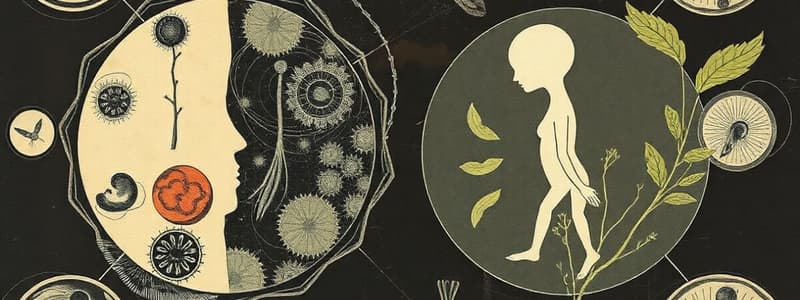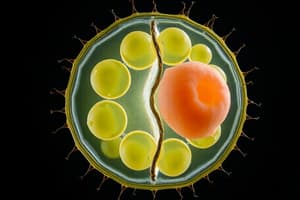Podcast
Questions and Answers
What is the primary purpose of cell division?
What is the primary purpose of cell division?
- To form new cells for growth, repair, and reproduction (correct)
- To maintain a constant number of cells throughout an organism's life
- To increase the size of an existing cell
- To eliminate unnecessary cells from the body
Which phase is NOT a part of interphase?
Which phase is NOT a part of interphase?
- S phase
- G2 phase
- M phase (correct)
- G1 phase
How do cancerous cells typically differ from healthy cells?
How do cancerous cells typically differ from healthy cells?
- Cancerous cells are uniformly benign
- Cancerous cells are more responsive to cell cycle checkpoints
- Cancerous cells have a longer lifespan and divide more slowly
- Cancerous cells often ignore cell cycle control mechanisms (correct)
Which of the following describes a tetrad during meiosis?
Which of the following describes a tetrad during meiosis?
What distinguishes plant cell cytokinesis from animal cell cytokinesis?
What distinguishes plant cell cytokinesis from animal cell cytokinesis?
In which phase of mitosis do chromatids separate and move towards opposite poles?
In which phase of mitosis do chromatids separate and move towards opposite poles?
Which of the following statements about gametes is correct?
Which of the following statements about gametes is correct?
What event occurs during crossing-over in meiosis?
What event occurs during crossing-over in meiosis?
What is a key difference between haploid and diploid cells?
What is a key difference between haploid and diploid cells?
What defines the term 'locus' in genetics?
What defines the term 'locus' in genetics?
Flashcards are hidden until you start studying
Study Notes
Cell Division and its Purposes
- Cell division is the process by which cells replicate.
- Cell division is essential for the growth and development of multicellular organisms, and also for repair and replacement of damaged cells.
Asexual vs. Sexual Reproduction
- Asexual reproduction involves the production of offspring from a single parent, with offspring genetically identical to the parent.
- Sexual reproduction involves two parent cells joining to produce offspring with a combination of genetic material from both parents.
Prokaryotic Cell Division (Binary Fission)
- Prokaryotes have circular chromosomes.
- Binary fission involves the following steps:
- Replication of the chromosome
- Separation of the copies to opposite ends of the cell
- Division of the cell into two daughter cells
Eukaryotic Chromosomes
- Eukaryotic chromosomes are linear and made of DNA with proteins.
- Chromatin consists of the complex of DNA and proteins.
- Sister chromatids are identical copies of a chromosome held together at the centromere.
The Eukaryotic Cell Cycle
- The eukaryotic cell cycle is a series of stages that a cell goes through from its formation to its division.
- Cell cycle phases include:
- Interphase:
- G1: Cell growth and normal function
- S: DNA Replication
- G2: Preparation for division
- Mitotic Phase:
- Mitosis: Nuclear division
- Cytokinesis: Cytoplasm division
- Interphase:
Mitosis
- Mitosis is the process of nuclear division.
- Mitosis stages include:
- Prophase: Condensation of chromosomes, nuclear envelope breakdown, formation of mitotic spindle
- Prometaphase: Attachment of chromosomes to spindle fibers
- Metaphase: Alignment of chromosomes at the metaphase plate
- Anaphase: Separation of sister chromatids, movement to opposite poles
- Telophase: Formation of daughter nuclei, uncondensed chromosomes, deconstruction of the spindle
Cytokinesis
- Cytokinesis is the division of the cytoplasm.
- Animal cells divide by cleavage furrow.
- Plant cells form a cell plate.
Cell Cycle Control System
- The cell cycle is regulated by a control system with checkpoints.
- Checkpoints ensure correct replication and division by monitoring the environment and cell readiness.
- G0 phase: A resting state where cells temporarily exit the cell cycle.
Cancerous Cells
- Cancerous cells differ from healthy cells by:
- Uncontrolled growth and division
- Ability to invade other tissues
- Ability to metastasize (spread to other parts of the body)
- Benign tumors remain localized.
- Malignant tumors spread and can be fatal.
Somatic Cells
- Somatic cells are non-reproductive cells of the body.
- Most somatic cells are diploid, meaning they contain two sets of chromosomes, one from each parent.
- Homologous pairs are chromosomes with the same genes, one from each parent.
- Autosomes are chromosomes that are not sex chromosomes.
- Sex chromosomes determine sex (X and Y in humans).
- Locus: The specific location of a gene on a chromosome.
Life Cycle, Gametes, and Fertilization
- A life cycle includes all the reproductive stages of an organism.
- Gametes are reproductive cells (sperm and egg in animals).
- Haploid cells have one set of chromosomes (n).
- Diploid cells have two sets of chromosomes (2n).
- Humans are diploid (2n = 46) with 23 chromosomes from each parent.
- Fertilization: The union of a sperm and an egg.
- Zygote: The fertilized egg, which is diploid (2n).
Meiosis
- Meiosis is a type of cell division that produces four haploid daughter cells from a single diploid cell.
- Meiosis I:
- Prophase I: Condensation of chromosomes, synapsis (pairing of homologous chromosomes), crossing over (exchange of genetic material between non-sister chromatids)
- Metaphase I: Alignment of homologous chromosome pairs at the metaphase plate
- Anaphase I: Separation of homologous chromosome pairs, moving to opposite poles
- Telophase I: Formation of two daughter nuclei, each with one chromosome from each homologous pair.
- Meiosis II: Similar to mitosis, but starting with haploid cells.
- Sister chromatids separate, resulting in four haploid daughter cells.
- Tetrad: Pair of homologous chromosomes, comprised of four chromatids altogether.
- Kinetochore: A protein structure at the centromere that attaches to spindle fibers.
Similarities and Differences between Mitosis and Meiosis
- Both involve chromosome duplication.
- Mitosis results in two identical diploid daughter cells for growth and repair.
- Meiosis results in four genetically different haploid daughter cells for sexual reproduction.
Genetic Variation in Sexual Reproduction
- Independent orientation: The random lining up of homologous chromosome pairs during Meiosis I.
- Random fertilization: The fusion of any sperm with any egg.
- Crossing-over: The exchange of genetic material between non-sister chromatids.
- Chiasma: The point of contact between non-sister chromatids during crossing over.
Karyotyping
- Karyotyping: A visual display of all chromosomes in a cell.
- Karyotyping is performed to:
- Detect chromosome abnormalities
- Identify the sex of an individual
- Determine the genetic basis of certain diseases.
Studying That Suits You
Use AI to generate personalized quizzes and flashcards to suit your learning preferences.




